Sustainable Water Management in a Krakow Housing Complex from the Nineteen-Seventies in Comparison with a Model Bio-Morpheme Unit
Abstract
:1. Introduction
- -
- determining the possibility of implementing integrated water management using rainwater in a housing estate built in the 1970s in Krakow (Poland) on the example of a selected, typical housing complex;
- -
- checking whether in the indicated housing complex it is possible to obtain water savings from the network by supplying rainwater to it and at the same time introducing an open reservoir or watercourse into the urban interior;
- -
- checking whether the proposed method of shaping the urban structure of a large housing estate, consisting of the separation of smaller spatial units, allows for better use of rainwater than at present. The object of reference for the research is a typical building in the city and its surroundings;
- -
- comparing the findings with the results of a reference unit. Checking the potential of the Bio-Morpheme complex solutions, by which the rationalization of water management has led to lower demand for water from the municipal water supply system and the amount of sewage produced, accompanied by introducing an open water reservoir into its urban interior layout [34].
2. Materials and Methods
- Territory—the area’s size is 100 × 90 m = 9000 m2
- Development features—two multiple-core-type buildings, each consisting of four segments with a height of five storeys
- Urban form type—linear development
- Number of residential units—sixty in each building, 120 in total
- Number of residents—assumed to be in compliance with the number estimated in the nineteen-seventies, with 220 residents in each building, making a total of 440
- Objective—balancing run-off from roofs, bicycle paths, roads, parking spaces and paved surfaces; determining rainwater-utilization potential with the intent of increasing savings on potable water and the creation of external water bodies/courses to improve the microclimate and small retention
- Climate conditions—standard for Krakow (Poland)
- Characteristics of the area selected for comparison—Bio-Morpheme [34]
- -
- The spatial structure of the area is based on the cooperation of infrastructures, according to Ken Yeang’s typology
- -
- The Bio-Morpheme is, as far as possible, autonomous in terms of the use and storage of rainwater within the blue infrastructure.
- -
- The Bio-Morpheme is assumed to be in the form of a building quarter, with a side length of 100 m, partially open, with a four-storey residential development enriched with service functions, pedestrian and vehicular traffic, with favourable interior proportions and of an interior size enabling the realization of a domestic program for residents and the introduction of a pond (see Figure 2).
- i.
- Greywater, i.e., wastewater from bathing, handwashing and laundry, will be collected and treated in simple installations (coalescent filter and pump if necessary), built-in bathroom structures of each flat, and used for toilet flushing; an excess volume of this water will be discharged to the sewerage; as these three streams create more wastewater than necessary for toilet flushing. This very process, flushing, will be a limiting factor for this way of water saving.
- ii.
- Rainwater from the roof will be collected in a rainwater harvesting tank, common for the entire Bio-Morpheme, and will then be pumped to a specific water line in the plumbing system to support each washing machine with water. The volume of the tank is assumed to be for three days of operation, i.e., 15 cubic meters. It would be equipped with a filtration unit (sieve) to remove particles, UV radiation for disinfection purposes, and quality control via a simple turbidimeter and pH meter online. Location of the tank and its dimensions will depend on the internal design and arrangements of the building. Calculations were made for a steady state based on real rainfall data for Krakow [34].
- Rainwater collected from the roofs of residential and commercial areas (see Figure 2), after basic water treatment processes, would be directed to a tank located in the underground part of the building (the capacity of the tank would be based on dimensions of an average three-day quantity of rainwater harvested from these collection areas, i.e., roofs). Rainwater requires minimum treatment (dust removal) and, due to its low hardness, is suited for laundries, differing from greywater streams in this feature. After such treatment, a separate internal distribution system would supply water to washing machines in individual residential units. Calculations warned that in winter months and some periods of summer a three-day period would not cover demand for laundry water. In such periods, without precipitation, washing machines would operate with tap water delivery through a three-way valve. As the authors’ observations confirmed that evaporation significantly reduces the volume of rainwater harvested when daily rainfall is below 1 mm/day, further calculations omit rainfall from such days.
- Car parks would be equipped with water collection/infiltration systems, such as Wavin Q-Bic, so it was assumed that this type of rainwater runoff would not be taken into water balance.
- Access roads, pavements and bicycle paths would be drained with the use of a stormwater drainage system compliant with the DWA-M 153 standard. This would ensure that pre-treatment conditions would be in accordance with the Regulation of the Minister of Maritime Affairs and Inland Navigation of 12 July 2019. Water collected from this part of the area would be directed to the ornamental/recreational element in the form of a pond for the Bio-Morpheme or a watercourse, a reservoir with an elongated shape adapted to the development layout of the Krakow-Morpheme. The reservoirs would have an average depth of 0.70 m. This depth was chosen for safety reasons, as a deeper pond requires protection barriers which could significantly degrade the landscaping of the entirety of the Bio-Morpheme. An analysis of the area size of this element is presented later in the paper.
3. Results
3.1. Estimations of Savings in Water Supply Needs Resulting from the Morpheme Dimensioning
3.2. Possible savings in tap water
- 140 L/person × day, as stipulated in Polish design standards [10];
- Toilet flushing 28.1%
- Laundry 22%
- Bathing 17%
- Unaccounted (losses) 13%
- Meal preparation 11%
- Dishwashing 3%
- Other needs (e.g., lawn watering) 2.2%
- Direct consumption 2%
- Hand washing 1.7%
4. Discussion
- Average savings of 34% on potable water from municipal system (grey water included)
- Less impact of the reservoir on surface load of sewerage (if constructed)
- Average savings of 47% on potable water from the municipal system
- Average reduction of 32% in load on surface-water sewer system during periods with highest rainfall (May-August)
5. Summary and Conclusions
- -
- -
- Reducing the cost. Traditional surface-water management systems for large areas must take into account the varied topography and existing underground infrastructure networks, roads, and existing buildings, significantly increasing investment costs. While small areas (morphs) with similar topographic characteristics reduce the costs associated with infrastructure and the pumping of water and wastewater in a given area. This is confirmed by the studies of Salvan, L. et al. [49] and Yifru, B. A. et al. [50];
- -
- Better utilisation of landforms, which are more homogeneous on the urban microscale;
- -
- Achieving Water Security and Resiliency. Diversifying water sources is critical for achieving water security and resilience. Morphemes provide additional water sources that are not used in existing centralized systems. Morphemes can be incorporated into centralized systems and, as a result, can improve water security. In addition, the morpheme system reduces the amount of water drawn from the centralized water source. Morphemes absorb disturbances and can independently adapt to the desired state. This is important when using rainwater, as confirmed by studies [51,52].
- It is asserted that the analysis results for the residential building from the nineteen-seventies are promising and the results indicate the feasibility of introducing the proposed solutions into the undergoing revitalization of Krakow’s housing estates, as well as in other sites with similar morphological features. (The two-building housing complex provides the potential for supporting the water-supply system and constructing an open-water reservoir).
- Solutions proposed in the article significantly increase the real feasibility of the idea of water reuse and RWH, all the more so because the pond proposed by the authors is a kind of water buffer reducing the nuisance of torrential rainfall, which is not taken into account in the quoted items [35,36,37,38,39,41,42,43].
- The conducted research has development potential and should initiate further works. The site development of housing estates from the nineteen seventies leaves little free space between buildings to construct open water reservoirs. It should be investigated whether it is possible to introduce watercourses, along with buildings, in adjacent green areas, with possible wider sections, which could contribute to the interior’s cross-ventilation and improve the microclimate, while the reservoir could be located outside the developed area in the recreational green zone. Introducing watercourses along buildings makes them visible from apartments (Figure 5). It is proposed to extend the investigation and indicate how the model in question could perform:
- in a complex of two buildings with a height of eleven storeys (the second type of development employed in housing estates from the nineteen-sixties and seventies alongside five-story buildings),
- in housing complexes built by real-estate developers in the nineteen-nineties and the beginning of the twenty-first century.
Author Contributions
Funding
Institutional Review Board Statement
Informed Consent Statement
Data Availability Statement
Acknowledgments
Conflicts of Interest
References
- United Nations Department of Economic and Social Affairs. World Urbanization Prospects: The 2018 Revision; United Nations: New York, NY, USA, 2019. [Google Scholar]
- Carter, J.G.; Cavan, G.; Connelly, A.; Guy, S.; Handley, J.; Kazmierczak, A. Climate change and the city: Building capacity for urban adaptation. Prog. Plan. 2014, 95, 1–66. [Google Scholar] [CrossRef]
- Competitive Cities and Climate Change. OECD Conference Proceedings, Milan, 9–10 OCTOBER 2008. Available online: https://www.oecd.org/cfe/regionaldevelopment/50594939.pdf (accessed on 1 January 2022).
- Roser, M.; Ortiz-Espina, E. World Population Growth. OurWorldInData.org. 2019. Available online: https://ourworldindata.org/world-population-growth (accessed on 12 January 2022).
- Ritchie, H.; Roser, M. Urbanization, Our World in Data.org. Available online: https://ourworldindata.org/urbanization/ (accessed on 12 December 2021).
- Corburn, J. Towards the Healthy City. People, Places, and the Politics of Urban Planning; The MIT Press: Cambridge, MA, USA, 2009. [Google Scholar]
- Iojă, C.I.; Badiu, D.L.; Haase, D.; Hossu, A.C.; Niță, M.R. How about water? Urban blue infrastructure management in Romania. Cities 2021, 110, 103084. [Google Scholar] [CrossRef]
- Miró, A.; Hall, J.E.; Rae, M.; O’Brien, C.D. Links between ecological and human wealth in drainage ponds in a fast-expanding city, and proposals for design and management. Landsc. Urban Plan. 2018, 180, 93–102. [Google Scholar] [CrossRef] [Green Version]
- Summers, J.K.; Smith, L.M.; Case, J.L.; Linthurst, R.A. A Review of the Elements of Human Well-Being with an Emphasis on the Contribution of Ecosystem Services. Ambio 2012, 41, 327–340. [Google Scholar] [CrossRef] [Green Version]
- Demographic Yearbook of Poland. GUS Poland. 2020. Available online: www.stat.gov.pl (accessed on 15 December 2021).
- Berkowska, E.; Gwiazdowicz, M. Deficyt Wody w Polsce. 2020, Biuro Analiz Sejmowych, Infos 1(267). Available online: http://orka.sejm.gov.pl/WydBAS.nsf/0/A8BC86EF5BC4E446C12584E900399A4B (accessed on 10 December 2021).
- Manteghi, G.; Bin Limit, H.; Remaz, D. Water bodies an urban microclimate: A review. Mod. Appl. Sci. 2015, 9, 1–12. [Google Scholar] [CrossRef] [Green Version]
- Haupt, P. Natural elements of composition in the space of housing complexes. Sr. Mieszk./Hous. Environ. 2018, 24, 89–98. [Google Scholar] [CrossRef] [Green Version]
- Rahman, S.; Khan, M.T.R.; Akib, S.; Bin Che Din, N.; Biswas, S.K.; Shirazi, K.M. Sustainability of Rainwater Harvesting System in terms of Water Quality. Sci. World J. 2014, 2014, 721357. [Google Scholar] [CrossRef]
- Solarek, K. Urban Design in Town Planning. Current Issues and Dilemmas from the Polish and European Perspective; Faculty of Architecture WUT: Warszawa, Poland, 2018. [Google Scholar]
- Bradecki, T.; Swoboda, J.; Nowak, K.; Dziechciarz, K. Study of Contemporary Housing Estates Implemented in Poland in 2003–2016; Wydawnictwo Politechniki Śląskiej: Gliwice, Poland, 2019. [Google Scholar]
- Stachura, E. Studies on current housing conditions in Poland: Urban scale and commonly used areas attributes in housing estates. Tech. Trans. 2013, 110, 125–135. Available online: https://repozytorium.biblos.pk.edu.pl/resources/30751 (accessed on 15 December 2021).
- Ogrodowczyk, A. Spatial aspects of housing policy transformation in Poland after 1989—Example from Lodz. J. Econ. Manag. 2015, 19, 137–154. [Google Scholar]
- Polanska, D.V. Urban policy and the rise of gated housing in post-socialist Poland. GeoJournal 2014, 79, 407–419. [Google Scholar] [CrossRef] [Green Version]
- Gronostajska, B. Kreacja i Modernizacja Przestrzeni Mieszkalnej. Teoria i Praktyka na Przykładzie Wybranych Realizacji Wrocławskich z lat 1970–1990; Oficyna Wydawnicza Politechniki Wrocławskiej: Wrocław, Poland, 2007. [Google Scholar]
- Ostańska, A. Wielka Płyta. Analiza Skuteczności Podwyższania Efektywności Energetycznej; PWN: Warszawa, Poland, 2016. [Google Scholar]
- Tofiluk, A.; Knyziak, P.; Krentowski, J. Revitalization of Twentieth-Century Prefabricated Housing Estates as Interdisciplinary Issue. IOP Conf. Ser. Mater. Sci. Eng. 2019, 471, 112096. [Google Scholar] [CrossRef]
- Gruszecka, K.; Gzell, S.; Rembarz, G. Osiedle: Reurbanizacja; Urbanista: Warszawa, Poland, 2009. [Google Scholar]
- Sprawozdanie z Monitorowania Miejskiego Programu Rewitalizacji Krakowa, Urząd Miasta Krakowa 2020, Kraków, Poland. Available online: https://www.bip.krakow.pl/plik.php?zid=282124&wer=0&new=t&mode=shw (accessed on 9 September 2021).
- Program Rewitalizacji Zabudowy Blokowej Osiedli na Terenie Gminy Miejskiej Kraków. Aktualizacja MPRK. Wydział ds. Przedsiębiorczości i Innowacji, Krakow, Poland. 2020. Available online: https://www.bip.krakow.pl/?dok_id=51896 (accessed on 19 December 2021).
- Wielokryterialna Analiza Dziewiętnastu Osiedli Zabudowy Blokowej Położonych na Terenie Gminy Miejskiej Kraków. Urząd Miasta Krakowa, Krakow, Poland. 2011. Available online: http://krakow.pl/data/rewitalizacja/27322_0.pdf?_ga=2.172258083.1298109433.1642345210-1628345790.1630074405 (accessed on 10 December 2021).
- Kobylarczyk, J.; Schneider-Skalska, G.; Haupt, P.; Racoń-Leja, K.; Sumlet, W.; Tor, P. Diagnoza Funkcjonalno-Przestrzenna Osiedli: Olsza II i Ugorek; CUT Press: Cracow, Poland, 2015. [Google Scholar]
- The New European Bauhaus. Available online: https://europa.eu/new-european-bauhaus/index_pl (accessed on 20 December 2021).
- Verma, P.; Singh, P.; Singh, R.; Raghubanshi, A.S. Urban Ecology. Emerging Patterns and Social-Ecological Systems; Elsevier Science Publishing Co Inc.: New York, NY, USA, 2020. [Google Scholar]
- Vlahov, D.; Galea, S. Urban health: A new discipline. Lancet 2003, 362, 1091–1092. [Google Scholar] [CrossRef]
- Georgiou, M.; Morison, G.; Smith, N.; Tieges, Z.; Chastain, S. Mechanisms of Impact of Blue Spaces on Human Health: A Systematic Literature Review and Meta-Analysis. Int. J. Environ. Res. Public Health 2021, 18, 2486. [Google Scholar] [CrossRef] [PubMed]
- Vale, B.; Vale, R. Green Architecture: Design for a Sustainable Future; Thames and Hudson: London, UK, 1991. [Google Scholar]
- Schneider-Skalska, G. Designing a Healthy Housing Environment. Selected problems; Lambert Academic Publishing: Saarbrucken, Germany, 2011. [Google Scholar]
- Rybicki, S.; Schneider-Skalska, G.; Stochel-Cyunel, J. Bio-Morpheme as innovative design concept for “Bio City” urban structure in the context of water saving and human health. J. Clean. Prod. 2022, in press. [Google Scholar]
- Chow, V.T.; Maidment, D.R.; Mays, L.W. Applied Hydrology; McGraw-Hill, Inc.: New York, NY, USA, 1988; 540p, ISBN 0070108102. [Google Scholar]
- Eurostat Statistics Explained. Water Statistics. Available online: https://ec.europa.eu/eurostat/statistics-explained/index.php?title=Water_statistics (accessed on 20 January 2022).
- Pinzon, T.M. Modelling and Sustainable Management of Rainwater Harvesting in Urban Systems. Ph.D. Thesis, Universitat Autònoma de Barcelona, Barcelona, Spain, 2012. [Google Scholar]
- Well, F.; Ludwig, F. Blue–green architecture: A case study analysis considering the synergetic effects of water and vegetation. Front. Archit. Res. 2020, 9, 191–202. [Google Scholar] [CrossRef]
- Godyn, I.; Grela, A.; Stajno, D.; Tokarska, P. Sustainable Rainwater Management Concept in a Housing Estate with a Financial Feasibility Assessment and Motivational Rainwater Fee System Efficiency Analysis. Water 2020, 12, 151. [Google Scholar] [CrossRef] [Green Version]
- Ward, S.; Memon, S.A.; Butler, D. Performance of a large building rainwater harvesting system. Water Res. 2012, 46, 5127–5134. [Google Scholar] [CrossRef]
- McGrane, S.J. Impacts of urbanisation on hydrological and water quality dynamics, and urban water management: A review. Hydrol. Sci. J. 2016, 61, 2295–2311. [Google Scholar] [CrossRef]
- Quinn, R.; Melville-Shreeve, P.; Butler, D.; Stovin, V. A critical evaluation of the Water Supply and Stormwater Management Performance of Retrofittable Domestic Rainwater Harvesting Systems. Water 2020, 12, 1184. [Google Scholar] [CrossRef] [Green Version]
- Yan, X.; Ward, S.; Butler, D.; Daly, B. Performance assessment and life cycle analysis of potable water production from harvested rainwater by a decentralized system. J. Clean. Prod. 2018, 172, 2167–2173. [Google Scholar] [CrossRef] [Green Version]
- Juan, Y.-K.; Chen, Y.; Lin, J.-M. Greywater Reuse System Design and Economic Analysis for Residential Buildings in Taiwan. Water 2016, 8, 546. [Google Scholar] [CrossRef]
- Campos Rodrigues, K.; Salomão Rael de Morais, L.; Martins de Paula, H. Green/sustainable treatment of washing machine greywater for reuse in the built environment. Clean. Eng. Technol. 2022, 6, 100410. [Google Scholar] [CrossRef]
- Zevenbergen, C.; Fu, D.; Pathirana, A. Transitioning to Sponge Cities: Challenges and Opportunities to Address Urban Water Problems in China. Water 2018, 10, 1230. [Google Scholar] [CrossRef] [Green Version]
- Karsu, O.; Kara, B.Y.; Akkaya, E.; Ozel, A. Clean Water Network Design for Refugee Camps. Netw. Spat. Econ. 2021, 21, 175–198. [Google Scholar] [CrossRef]
- Sitzenfrei, R.; Wang, Q.; Kapelan, Z.; Savić, D. Using Complex Network Analysis for Optimization of Water Distribution Networks. Water Resour. Res. 2020, 56, e2020WR027929. [Google Scholar] [CrossRef] [PubMed]
- Salvan, L.; Abily, M.; Gourbesville, P.; Schoorens, J. Drainage System and Detailed Urban Topography: Towards Operational 1D-2D Modelling for Stormwater Management. Procedia Eng. 2016, 154, 890–897. [Google Scholar] [CrossRef] [Green Version]
- Yifru, B.A.; Chung, I.; Kim, M.; Chang, S.W. Assessment of Groundwater Recharge in Agro-Urban Watersheds Using Integrated SWAT-MODFLOW Model. Sustainability 2020, 12, 6593. [Google Scholar] [CrossRef]
- Canales, F.; Gwoździej-Mazur, J.; Jadwiszczak, P.; Struk-Sokołowska, J.; Wartalska, K.; Wdowikowski, M.; Kaźmierczak, B. Long-Term Trends in 20-Day Cumulative Precipitation for Residential Rainwater Harvesting in Poland. Water 2020, 12, 1932. [Google Scholar] [CrossRef]
- Werbelo, L.; Brown, R. Working towards sustainable urban water management: The vulnerability blind spot. Water Sci. Technol. 2011, 64, 2362–2369. [Google Scholar] [CrossRef]
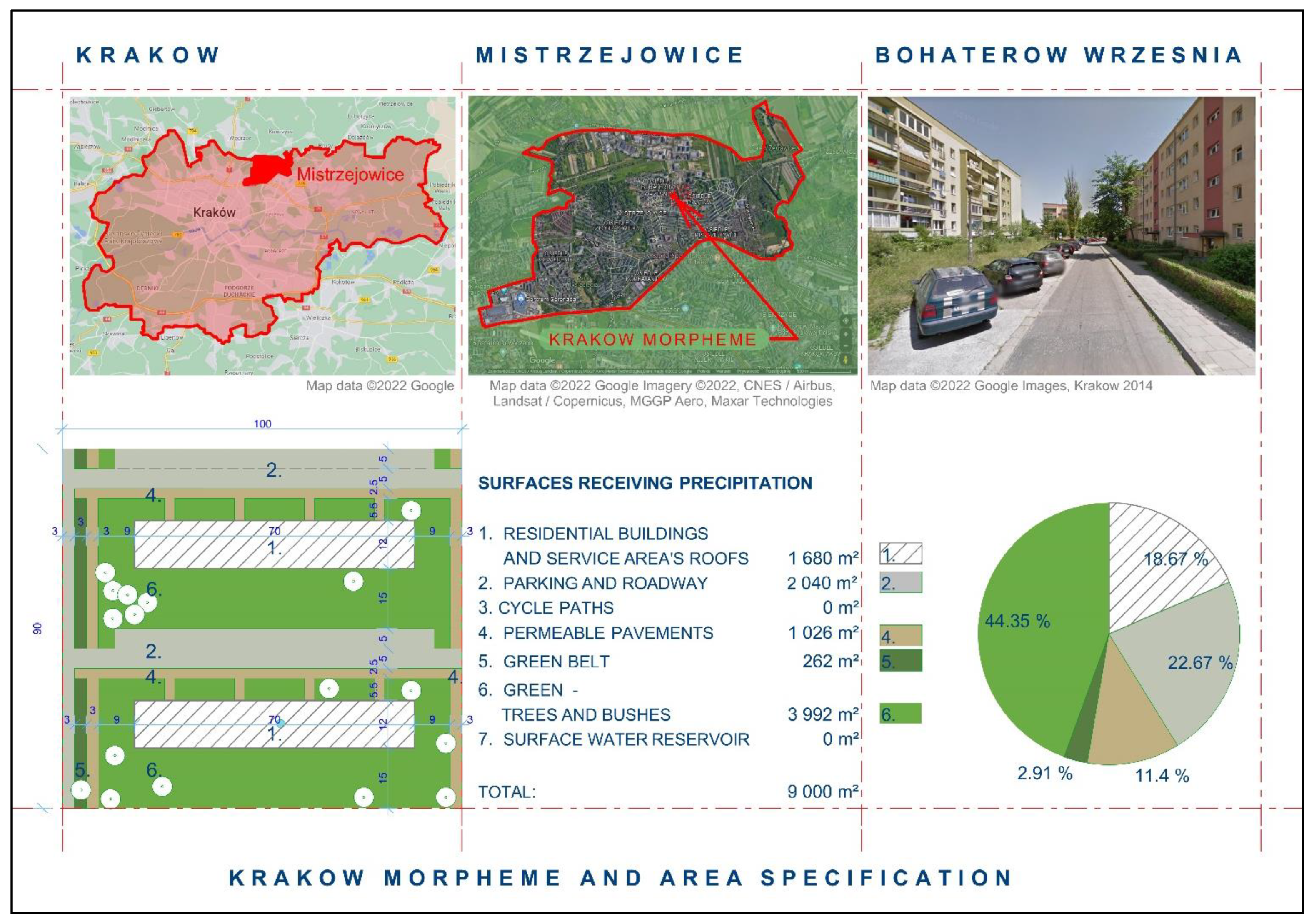
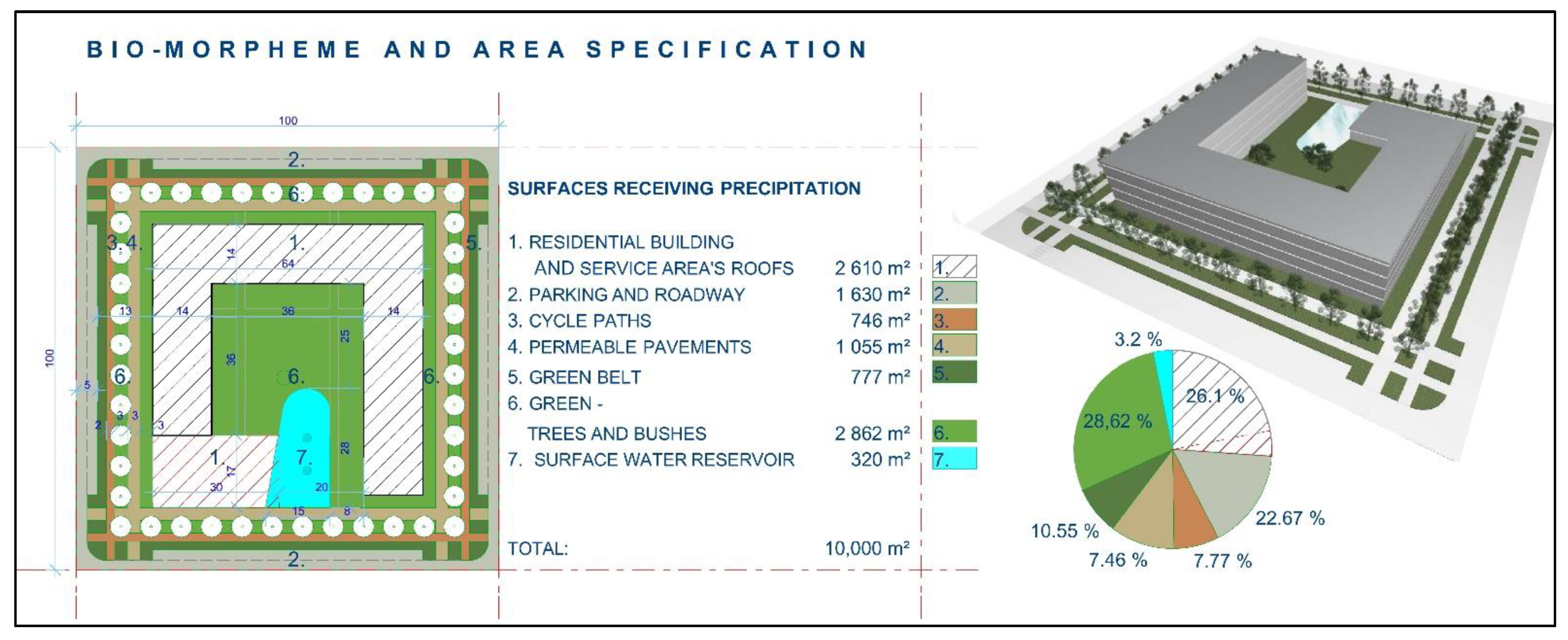
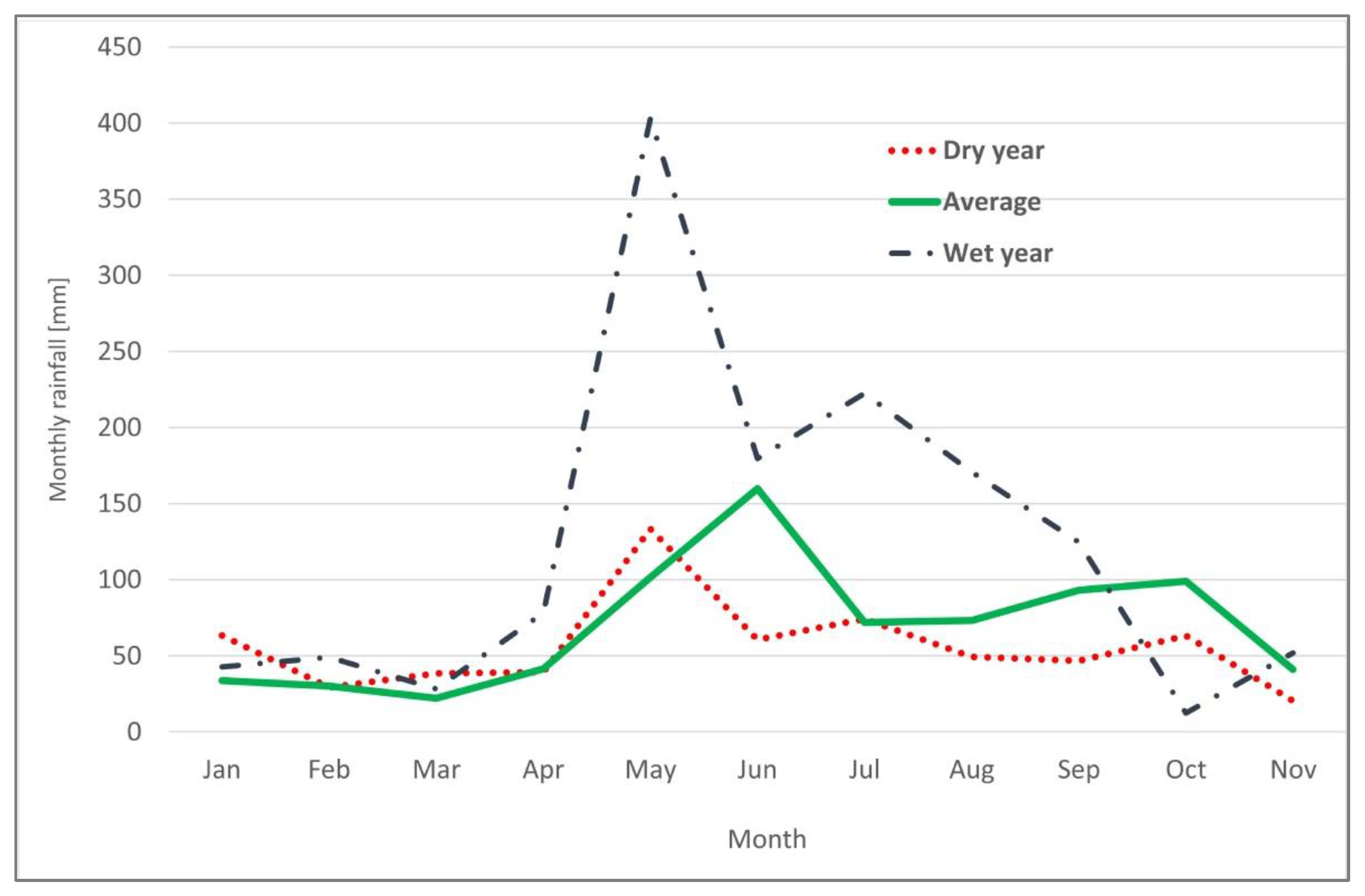
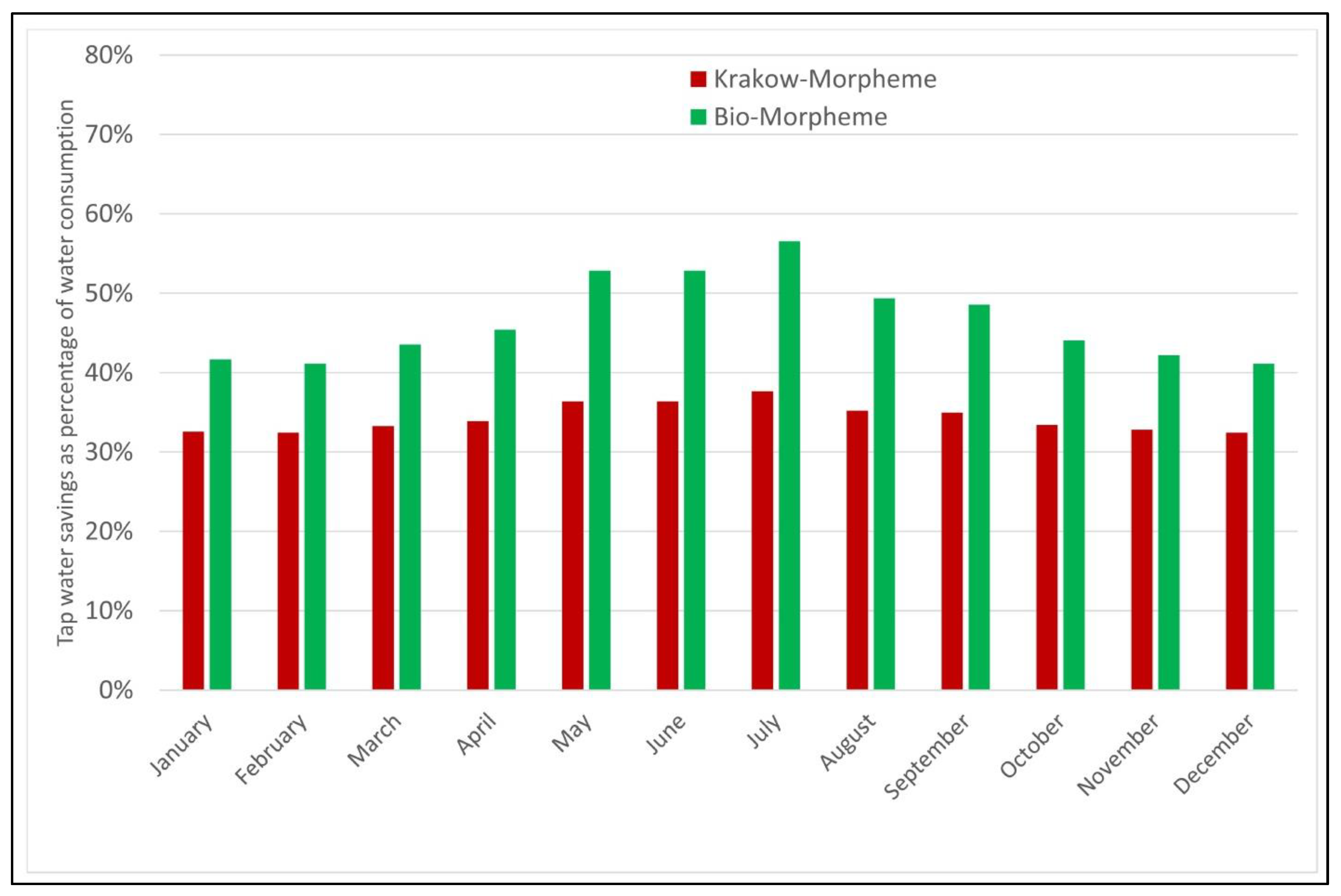
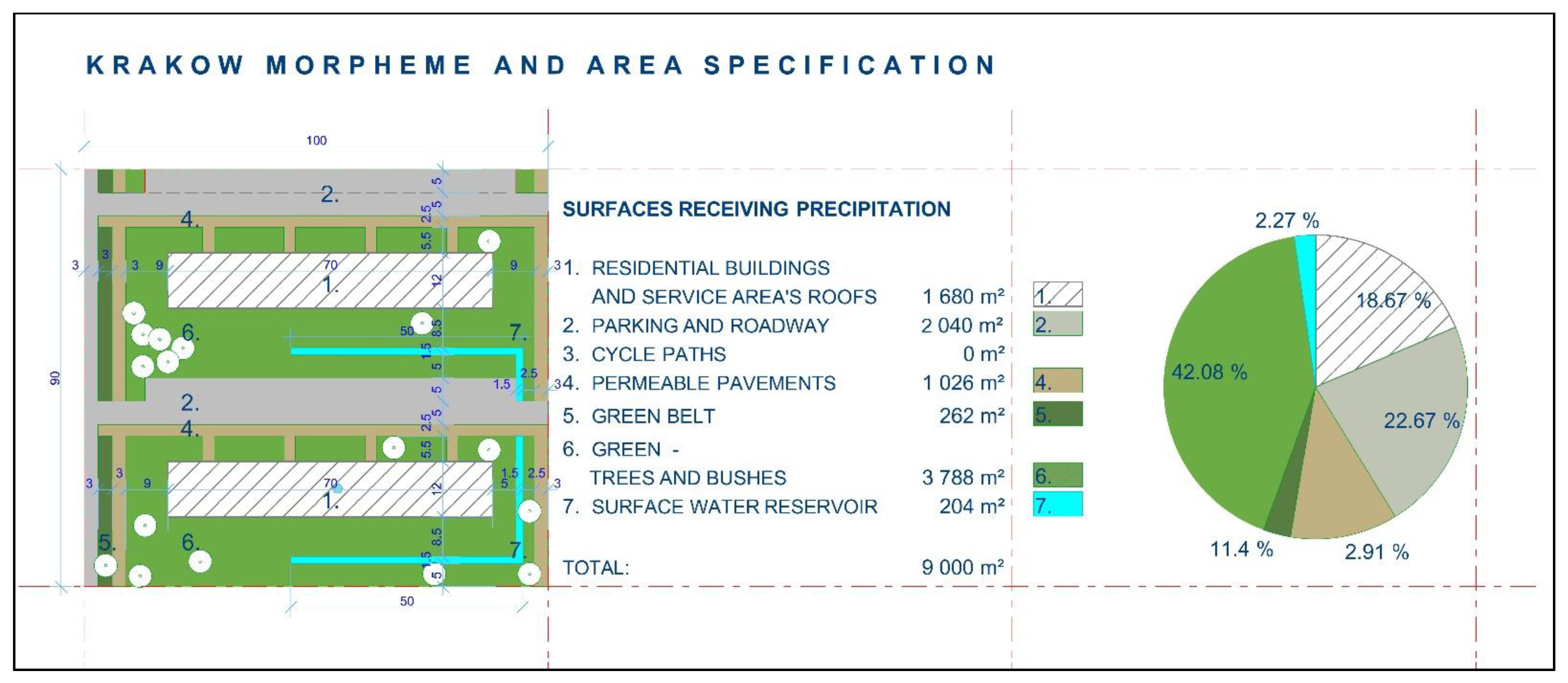
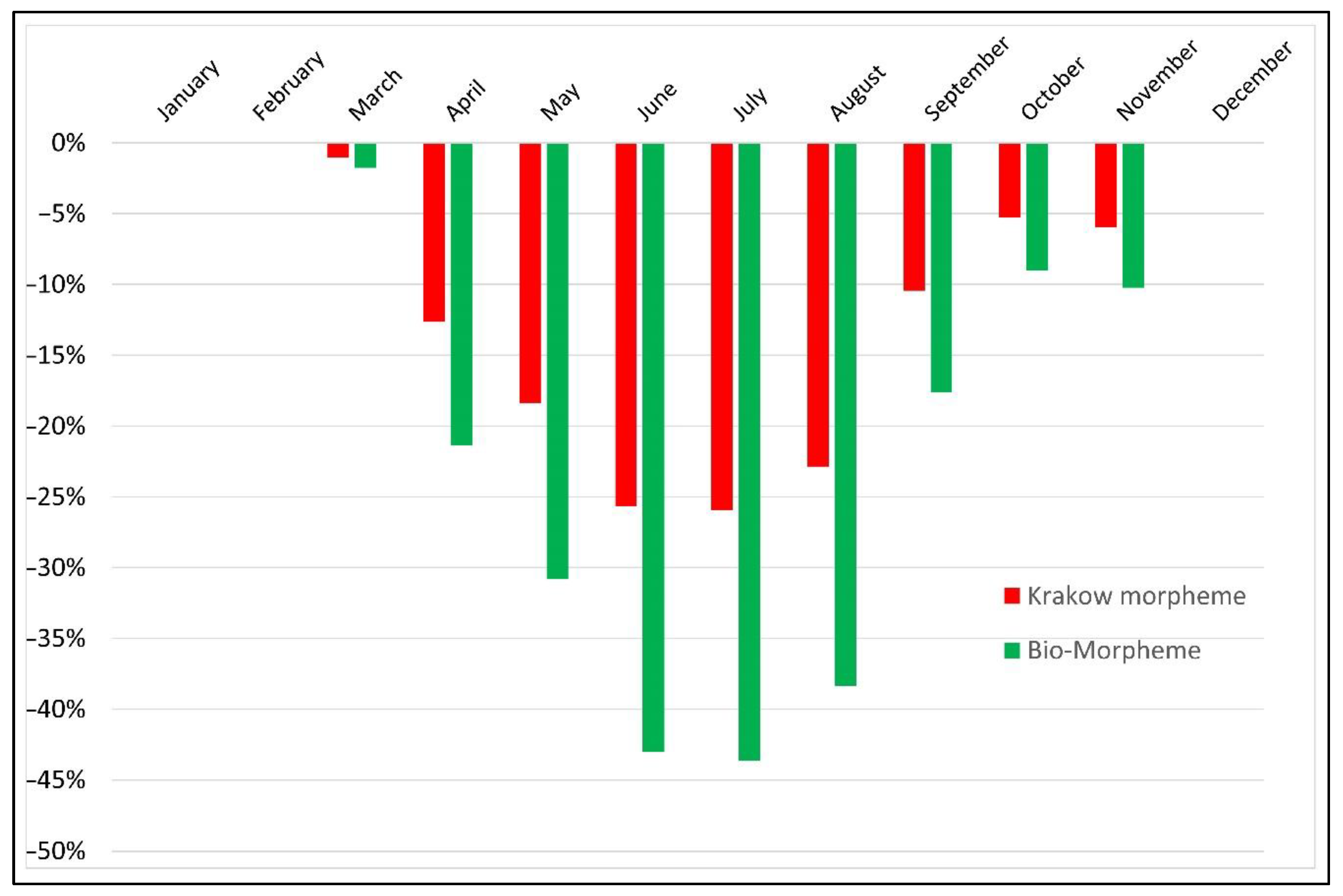
| Research Field | Element Expectations | Effect Features | Results | Occurrence of the Features in Krakow-Morpheme | Occurrence of the Features in Bio-Morpheme |
|---|---|---|---|---|---|
| The architectural and urban structure of housing development [13,29,30,31,32,33,34] | The form of the residential unit and land development preferences–partially open forms, proportions of the neighborly interior | 1:3 - the proportions of the building height to the width of the open interior | sense of comfort and security | YES | YES |
| Scale and proportionsROMANIApreferences—a human scale of development | From 3 to 5 storeys | sense of comfort and a human scale | YES | YES | |
| Concept of housing development preferences—striving to live in a group called neighborhood | 200–500 inhabitants - the size of the development unit favours the creation of a neighborly space | sense of comfort | YES | YES | |
| Function in the residential unit preferences—an attractive recreational program in the neighborhood space | adequate space for recreation resulting from the proportions of the urban interior | increase of well-being | YES | YES | |
| Research Field | Element Expectations | Effect Features | Results | Occurrence of the features in Krakow-Morpheme | Occurrence of the features in Bio-Morpheme |
| Water in residential environment [12,13,14,24,29,31,32,33,34,35] | Water management Preferences - water retention in the morpheme, - rainwater reusing, storage and recycling in site | Introduction solutions of blue-green engineering | Increase of water safety | NO | YES |
| The required infrastructure and water use efficiency Preferences: - Sufficient amounts of water to meet the living needs of the inhabitants; - Striving to save water from water supply systems without reducing comfort and without affecting health of residents negatively | Reuse of rainwater and greywater in the building | Reduction of no less than 40% of the Monthly consumption of tap-water | NO | YES | |
| Research Field | Element Expectations | Effect Features | Results | Occurrence of the features in Krakow-Morpheme | Occurrence of the features in Bio-Morpheme |
| Healthy residential environment (In aspect of water use) [8,9,12,14,24,29,30,31,32,33,34,35] | Structure of the land development preferences—the need for contact with elements of nature, including an open water reservoir—to ensure physical and mental health | Introduction solutions of blue-green engineering | Increase of Well-being | NO | YES |
| Climatic comfort preferences—the need to stay in a healthy environment ensuring climatic comfort (including adequate humidity and water availability) | Introduction solutions of blue-green engineering including the open water reservoir | Lowering the perceived temperature, improving ventilation and humidity | NO | YES |
| Surface | Krakow-Morpheme | Bio-Morpheme | ||
|---|---|---|---|---|
| Surface Area [m2] | Percentage of the Krakow-Morpheme Total Surface Area [%] | Surface Area [m2] | Percentage of the Bio-Morpheme Total Surface Area [%] | |
| Roofs of residential building and service areas | 1680 | 18.67 | 2610 | 26.10 |
| Parking and road way | 2040 | 22.67 | 1630 | 16.30 |
| Cycle paths | 0 | 0 | 746 | 7.46 |
| Permeable pavements | 1026 | 11.40 | 1055 | 10.55 |
| Green belt | 262 | 2.91 | 777 | 7.77 |
| Greenery: trees and bushes | 3992 | 44.35 | 2862 | 28.62 |
| Surface-water reservoir | 0 | 0 | 320 | 3.20 |
| Total surface area | 9000 | 100 | 10,000 | 100 |
| Purpose of Water Use | Percentage Share of Water Consumption in Daily Water Consumption | Purpose of the Use | Whether this Can Be Substituted by Rainwater |
|---|---|---|---|
| Dishwashing | 3% | Toilet flushing | No |
| Laundry | 22% | Yes | |
| Bathing | 17% | No | |
| Washing hands | 1.7% | No |
| Measuring Time Period | RWH Effective [L/d] | Grey Water [L/d] | Tap Water [L/d] | Savings [L/d] | Savings as Percentage of Total Consumption |
|---|---|---|---|---|---|
| Krakow-Morpheme | |||||
| Monthly max | 5894 | 17,248 | 41,553 | 23,142 | 38% |
| Month. aver. | 3833 | 17,248 | 40,428 | 21,081 | 34% |
| Monthly min | 2699 | 17,248 | 38,358 | 19,947 | 32% |
| Bio-Morpheme | |||||
| Monthly max | 9156 | 9048 | 18,959 | 18,204 | 57% |
| Month. aver. | 5955 | 9048 | 17,197 | 15,003 | 47% |
| Monthly min | 4193 | 9048 | 13,996 | 13,241 | 41% |
| Surface | Krakow-Morpheme | Krakow-Morpheme with Integrated Water Management | Bio-Morpheme | |||
|---|---|---|---|---|---|---|
| Surface Area [m2] | Percentage of the Krakow-Morpheme Total Surface Area [%] | Surface Area [m2] | Percentage of the Krakow-Morpheme Total Surface Area [%] | Surface Area [m2] | Percentage of the Bio-Morpheme Total Surface Area [%] | |
| Roofs of residential buildings and service areas | 1680 | 18.67 | 1680 | 18.67 | 2610 | 26.10 |
| Greenery: trees and bushes | 3992 | 44.35 | 3788 | 42.08 | 2862 | 28.62 |
| Permeable pavements | 1026 | 11.40 | 1026 | 11.40 | 1055 | 10.55 |
| Green belt | 262 | 2.91 | 262 | 2.91 | 777 | 7.77 |
| Parking and road way | 2040 | 22.67 | 2040 | 22.67 | 1630 | 16.30 |
| Cycle paths | 0 | 0 | 0 | 0 | 746 | 7.46 |
| Surface-water reservoir | 0 | 0 | 204 | 2.27 | 320 | 3.20 |
| Total surface area | 9000 | 100 | 9000 | 100 | 10,000 | 100 |
| Specific Value [m3/month] | Krakow-Morpheme | Bio-Morpheme | ||
|---|---|---|---|---|
| Water Harvested | Water Evaporated/Used | Water Harvested | Water Evaporated/Used | |
| Monthly maximum | 437 | 41 | 254 | 111 |
| Average | 292 | 113 | 170 | 40 |
| Monthly minimum | 200 | 0 | 116 | 0 |
Publisher’s Note: MDPI stays neutral with regard to jurisdictional claims in published maps and institutional affiliations. |
© 2022 by the authors. Licensee MDPI, Basel, Switzerland. This article is an open access article distributed under the terms and conditions of the Creative Commons Attribution (CC BY) license (https://creativecommons.org/licenses/by/4.0/).
Share and Cite
Bonenberg, W.; Rybicki, S.M.; Schneider-Skalska, G.; Stochel-Cyunel, J. Sustainable Water Management in a Krakow Housing Complex from the Nineteen-Seventies in Comparison with a Model Bio-Morpheme Unit. Sustainability 2022, 14, 5499. https://doi.org/10.3390/su14095499
Bonenberg W, Rybicki SM, Schneider-Skalska G, Stochel-Cyunel J. Sustainable Water Management in a Krakow Housing Complex from the Nineteen-Seventies in Comparison with a Model Bio-Morpheme Unit. Sustainability. 2022; 14(9):5499. https://doi.org/10.3390/su14095499
Chicago/Turabian StyleBonenberg, Wojciech, Stanisław M. Rybicki, Grażyna Schneider-Skalska, and Jadwiga Stochel-Cyunel. 2022. "Sustainable Water Management in a Krakow Housing Complex from the Nineteen-Seventies in Comparison with a Model Bio-Morpheme Unit" Sustainability 14, no. 9: 5499. https://doi.org/10.3390/su14095499
APA StyleBonenberg, W., Rybicki, S. M., Schneider-Skalska, G., & Stochel-Cyunel, J. (2022). Sustainable Water Management in a Krakow Housing Complex from the Nineteen-Seventies in Comparison with a Model Bio-Morpheme Unit. Sustainability, 14(9), 5499. https://doi.org/10.3390/su14095499






